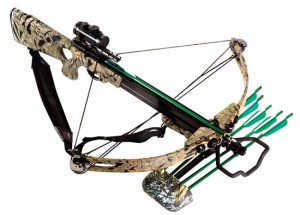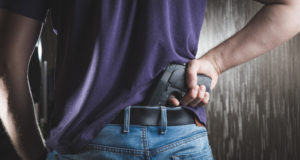 A crossbow, resembling something between a rifle and a bow, uses a fast string to launch projectiles—just as a bow does—but also has a stock and trigger like a rifle. Although we don’t know exactly when the crossbow was invented, they were discovered in Chinese graves dating back as early as 2500 B.C. The crossbow was also used by the Greeks in 5th century B.C. The Greeks realized that there was a definite advantage to the crossbow over a traditional bow and this discovery revolutionized their success on the battlefield. The crossbow became the weapon of choice because of its versatility and accuracy.
A crossbow, resembling something between a rifle and a bow, uses a fast string to launch projectiles—just as a bow does—but also has a stock and trigger like a rifle. Although we don’t know exactly when the crossbow was invented, they were discovered in Chinese graves dating back as early as 2500 B.C. The crossbow was also used by the Greeks in 5th century B.C. The Greeks realized that there was a definite advantage to the crossbow over a traditional bow and this discovery revolutionized their success on the battlefield. The crossbow became the weapon of choice because of its versatility and accuracy.
Although the first crossbow doesn’t look anything like what they do now, early crossbows were constructed in much the same manner; primarily, they were bows mounted across wooden tillers or stocks. When the crossbow was fired, an arrow or bolt moved down a channel in the tiller/stock. Later, devices were built in to make it easier to draw the string back. One common device was called a stirrup and it was built on the front of the crossbow. This allowed the archer to brace the crossbow with a foot and draw the string with both hands. Some men used hooks attached to their belts.
The design of the modern crossbow has many improvements over the earlier design. Earlier crossbows were simple pieces of wood with ends that were connected by a bowstring. Modern bows have more effective shapes and are constructed out of better materials. As a result, they are much more accurate and far more powerful.
Crossbows versus Traditional Bows
Ordinary bows require a great deal of physical strength and training, where crossbows do not. With a traditional bow, the archer must draw, aim, and shoot in rapid succession. The longer it takes to aim, the more tired the archer’s arm becomes, which lessens his accuracy. If one uses a crossbow instead, he can draw the string, cock the crossbow, and then leave it cocked until the archer is ready to fire.
Another benefit to the crossbow takes the archer’s stature into consideration. If an archer is short in stature, it may be difficult for him to use a long bow and the crossbow then becomes a better option. If the archer doesn’t have a lot of upper body strength, drawing back a traditional bow can be difficult. Unlike a traditional bow, the archer’s size and upper body strength doesn’t come into play quite as much with regards to the crossbow. With a crossbow, an archer can use his thigh and buttock muscles (the body’s strongest muscle groups) to cock the crossbow. There are also tools available, like levers or cranks, available to him to increase his ability in this area. So basically, a crossbowman is able to use a more powerful weapon than a traditional archer with the same amount of physical strength.
How a Crossbow Works
Modern crossbows are usually made from very strong, lightweight materials like various woods, plastics, and even bone. They also have accessories such as adjustable stocks, scopes, and other attachments to make the use of the crossbow more efficient. Yet, they are still basically a bow and arrow that is operated by spring action. What happens when you draw a bow is that you pull one end of a spring and it stores elastic potential energy until you let go of it. Its potential energy becomes energy movement, which allows the spring to snap back to its original shape. The movement and energy of the spring action propels the arrow from the bow at a high rate of speed.
There are several factors that affect a bow’s length and draw weight, and that will change the velocity an arrow will travel including its size, shape, and composition. As a result a simple short bow will not be as powerful as a simple long bow. Larger crossbows that a crossbowman aims from the shoulder are more powerful than smaller, handheld crossbows. Because some crossbows can have an arrow speed of 292 feet per second or more, it is absolutely critical that you know how to safely handle your crossbow.
Handling Your Crossbow Safely
The crossbow is a lethal weapon and it is important to follow assembly instructions provided with your crossbow. The crossbow is a weapon designed primarily for hunting large game, so it is fast, powerful, and it produces high energy. Therefore, care must be taken to handle a crossbow safely. Here are some safety tips:
- Before using your crossbow, examine it for worn cables and strings, missing strings, and loose or damaged parts. Never use your crossbow unless it is in top condition.
- The forehand grip on a crossbow is positioned to keep your thumb and fingers from getting injured. Never hold the forehand grip in a position where your thumb extends above the flight deck in the way of the strings. Always keep your fingers on the forehand grip above the flight deck so they don’t interfere with the string. Never have your hands or fingers positioned on the forehand grip where they are in front of the cable or string.
- Don’t cock your bow until you are ready to use it.
- Use the proper arrow for the model of crossbow you possess.
- Grip firmly when you cock your crossbow, otherwise the string can slip and cause serious injury.
- Never point at anything you don’t intend to shoot.
- When pointing at a target, make sure people are standing well behind you.
- Never release the trigger safety until you are aiming at your target. Crossbows have an automatic safety that engages as soon as you cock the bow. Some have a separate manual safety that you can engage yourself. Either way, the safety will keep you from firing the bow accidentally. However, once you release the safety, be sure your target is in sight.
- Never walk or hike with an arrow loaded in your crossbow.
- It is not safe to manually unload a crossbow. So if you don’t take a shot, carry old arrows with a field tip and fire it into a bale of hay or some other inert object to discharge the arrow.
- Never dry fire your crossbow or use it with bolts lighter than those it’s made to use. Choose bolts that correspond to the size and weight of the bolt your model of crossbow fires. Using a light bolt with a very strong crossbow can cause the bolt to fly erratically and can damage the bow and cause injuries to you or others.
Today crossbows are popular weapons amongst recreationists and big games hunters alike. They recreationally, can be a great deal of fun for both amateurs and pros. But before using a crossbow, be sure to research the laws in your state, because laws governing crossbow use vary widely from state to state. Some laws allow only disabled hunters to use crossbows, while others allow anyone to use a crossbow. So know the laws, understand that this is a lethal weapon, and if you decide to buy a crossbow, learn how to handle it safely to avoid unnecessary injuries.
 Off The Grid News Better Ideas For Off The Grid Living
Off The Grid News Better Ideas For Off The Grid Living



